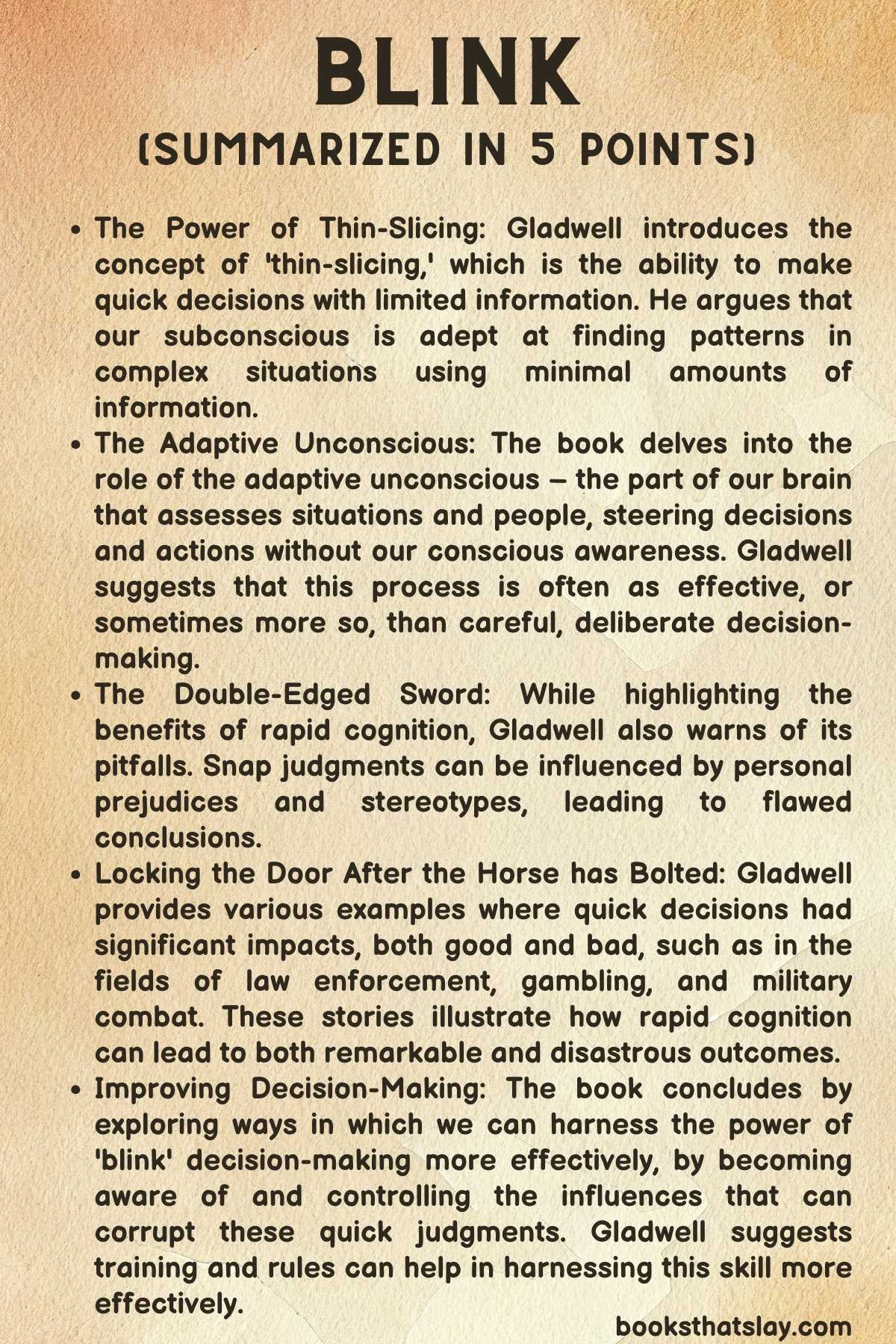Blink by Malcolm Gladwell Summary and Key Lessons
“Blink: The Power of Thinking Without Thinking,” written by Malcolm Gladwell and published in 2005, delves into the human ability to make rapid, intuitive judgments. The book is structured around the central thesis that our unconscious mind is capable of finding patterns in situations and behavior based on very narrow slices of experience.
Gladwell, a journalist known for his work in The New Yorker, brings together a wealth of psychological research, real-life stories, and his own insightful commentary to explore the complex nature of snap decisions.
Full Summary
In the opening chapters, Gladwell introduces the concept of “thin-slicing,” the idea that our unconscious can extract meaningful conclusions from very limited amounts of information.
He uses a variety of examples to illustrate this, such as art experts who can spot a fake at a glance and marriage counselors who can predict divorce with surprising accuracy after observing a couple for just a few minutes.
These examples serve to illustrate the remarkable capacity of our subconscious processing, which can often be faster and more accurate than our deliberate and conscious thought processes.
However, Gladwell also warns against the overconfidence in snap judgments, as they can be influenced by personal biases and incomplete information.
A central theme of “Blink” is the exploration of when and why these quick decisions can be trusted or when they lead us astray.
Gladwell delves into the science of “priming” – how our unconscious attitudes and feelings can be influenced without our awareness. For instance, he discusses experiments where subjects were primed with words associated with old age, leading them to walk slower.
This concept extends to more serious issues such as racial bias and stereotypes. Gladwell suggests that our snap judgments and gut feelings are not inherently infallible and can be affected by our environment, experiences, and cultural conditioning.
In later chapters, Gladwell discusses the conditions under which intuitive judgments can be improved and refined.
He uses the case of Paul Van Riper, a military commander in a war simulation, to demonstrate how intuition can be honed by experience and expertise.
Van Riper’s success in the simulation was attributed to his ability to make fast, intuitive decisions based on his deep understanding of military strategy.
This section of the book highlights the potential for training and experience to improve our ability to make quick, effective decisions, while also acknowledging that certain complex or unfamiliar situations may require more deliberate and analytical thinking.
Finally, Gladwell wraps up the book by emphasizing the balance between intuition and rational analysis.
He suggests that while our instinctive reactions can be powerful and often accurate, they are also susceptible to hidden prejudices and unconscious biases.
The key, according to Gladwell, is to understand the limits of our intuition and to create environments where our snap judgments can be as informed and unbiased as possible.
This involves being aware of and controlling the influences that can corrupt our subconscious decision-making processes.

Also Read: Difficult Conversations Summary and Key Lessons
Key Lessons
1. Trust in the Power of Intuitive Decision-Making
Our subconscious minds are capable of processing vast amounts of information rapidly, often leading to decisions that are as accurate, if not more so, than those made through a lengthy, analytical process.
Gladwell demonstrates through various examples, from art experts identifying forgeries to soldiers making split-second decisions in combat, that our intuition is a powerful tool.
This lesson encourages us to recognize and trust our gut feelings in situations where we have sufficient expertise or experience, acknowledging that sometimes the best decision can come from a ‘blink’ moment.
2. Awareness of Unconscious Biases
While Gladwell emphasizes the strength of intuition, he also cautions against the unconscious biases that can infiltrate snap judgments. These biases are often influenced by our background, experiences, and societal conditioning, and they can lead to flawed conclusions.
For instance, the book discusses how racial prejudices or stereotypes can unknowingly affect our decisions.
This lesson is crucial for understanding the limitations of intuitive thinking and for striving to make more informed and fair judgments. It underscores the importance of self-awareness and the continuous effort to recognize and mitigate our inherent biases.
Also Read: What Got You Here Won’t Get You There Summary and Key Lessons
3. Balancing Intuition and Analysis
Gladwell argues that while intuition is powerful, it’s not infallible.
There are situations where slow, deliberate, and rational analysis is necessary, especially in complex or unfamiliar scenarios. The book encourages readers to discern when to rely on their gut feelings and when to take a step back for a more measured and thorough evaluation.
This lesson teaches the importance of flexibility in decision-making approaches, tailoring the method to the nature of the decision at hand, and the context in which it is made.
Final Thoughts
“Blink” is a compelling exploration of the unconscious mind, urging readers to appreciate the power and potential pitfalls of our snap judgments, and to find the right balance between intuition and deliberate thought in our decision-making processes.
Read our other summaries